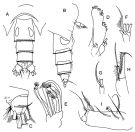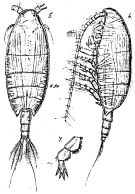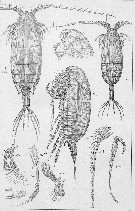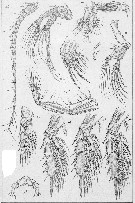|
|
 |
|
Calanoida ( Order ) |
|
|
|
Clausocalanoidea ( Superfamily ) |
|
|
|
Phaennidae ( Family ) |
|
|
|
Xanthocalanus ( Genus ) |
|
|
| |
Xanthocalanus fallax Sars, 1919 (F,M) | |
| | | | | | | Syn.: | Xanthocalanus borealis : Sars, 1902 (1903) (part.,p.46, figs.F,M); 1921 (p.3); Farran, 1905 (part., p.38, figs.F); Wilson, 1932 a (p.70, figs.F,M) | | | | Ref.: | | | Sars, 1919 (1921) (p.3, 4, Rem.); 1925 (p.128, Descr.F, figs.F); Rose, 1933 a (p.130, figs.F); Sewell, 1948 (p.501); Matthews, 1964 (p.29, figs.F,M, juv.); Bradford & al., 1983 (p.60, 71); Markhaseva & Schnack-Schiel, 2003 (p.112, Rem.); Bradford-Grieve, 2004 b (p.635, figs.F, tab.1); Vives & Shmeleva, 2007 (p.699, figs.F,M, Rem.) |  issued from : J.M. Bradford in N.Z. Jl Mar. Freshw. Res., 2004, 38 (4). [p.636, Fig.10]. Female (from Raunefjord, Norway): A, urosome (dorsal); B, idem (lateral right side); C, caudal ramus (ventral); D, Mx1: coxal endites 1, 2; basal endites and endopod; E, endopod of Mx2; F, praecoxal endite 1 of Mx2; G, coxal endite of Mx2; H, basal endite of Mx2; i, syncoxa of Mxp. Nota: Head and 1st thoracic segment with very faint fusion-line (evident dorsally), 4th and 5th fused (fusion line visible only only dorsally). Surfaces urosomal segments (not including anal segment) sparsely covered in very small semicircular thickenings (that probably represent place of attachment of large scales (evident in some individuals). A1 extending to posterior border of genital segment.
|
 issued from : J.M. Bradford in N.Z. Jl Mar. Freshw. Res., 2004, 38 (4). [p.637, Fig.11]. Female: A, endopod of P2; B, endopod of P3; C, endopod of P4; D, exopodal segment 2 and 3 of P4; E, P5 (posterior view); F, P5 coxa another posterior view.
|
 Issued from : G.O. Sars in Résult. Camp. Scient. Prince Albert I, 69, pls.1-127 (1924). [Pl.XXXV, figs.5-7]. Female: 5, habitus (dorsal); 6, idem (lateral left side); 7, P5.
|
 issued from : Sars G.O. in An Account of the Crustacea of Norway, with short descriptions and figures of all species. Vol. IV. Copepoda Calanoida. Publ. by The Bergen Museum. 1903. [Pl. XXXI]. As Xanthocalanus borealis. Female & Male.
|
 issued from : Sars G.O. in An Account of the Crustacea of Norway, with short descriptions and figures of all species. Vol. IV. Copepoda Calanoida. Publ. by The Bergen Museum. 1903. [Pl. XXXII]. As Xanthocalanus borealis. Female. M = Md; m = Mx1; mp1 = Mx2; mp2 = Mxp.
| | | | | Compl. Ref.: | | | Jespersen, 1939 (p.58, Rem.); Matthews, 1967 (p.159, Table 1, Rem.); Kovalev & Shmeleva, 1982 (p.83); Holmes, 2001 (p.56) | | | | NZ: | 5 | | |
|
Distribution map of Xanthocalanus fallax by geographical zones
|
| | | | | | | Loc: | | | Woods Hole, Azores, SE Greenland (rare), W Ireland, W Norway, Bergen: Raunefjord (all the year), North Sea, W Medit. (off Monaco in Sars, 1925) | | | | N: | 10 | | | | Lg.: | | | (1) F: 2,9; (45) F: 4-3; M: 3-2; (58) F: 3,5; (65) F: 3,5; M: 2,5; (897) F: 3,1-3,3; (1129) F: 2,89; {F: 2,89-4,00; M: 2,00-3,00} | | | | Rem.: | depths: 120-625 m.
Some authors do not recognize the identity of the male of this species.
This species can be confused with X. borealis. Bradford & al. (1983, p.60) underline that Matthews (1964) made a few observations on the life history of this species in Norwegian waters: the scarcity of nauplii in samples and the early appearance of young copepodites after an increase in males suggests the naupliar phase in short; it is possible that the number of stages is reduced since a narrow range of naupliar structure was observed; it appears the nauplii do not feed, as the yolk supply persists until the first copepodite stage. The annual life cycle consists of 3 main breeding seasons beginning in February, June and October, which results in peaks of young copepodites in March, August and September. The August peak is greatest, and after each peak the abundance of males falls rapidly. The adult male does not feed and has only a short life. | | | Last update : 08/04/2021 | |
|
|
 Any use of this site for a publication will be mentioned with the following reference : Any use of this site for a publication will be mentioned with the following reference :
Razouls C., Desreumaux N., Kouwenberg J. and de Bovée F., 2005-2025. - Biodiversity of Marine Planktonic Copepods (morphology, geographical distribution and biological data). Sorbonne University, CNRS. Available at http://copepodes.obs-banyuls.fr/en [Accessed January 02, 2026] © copyright 2005-2025 Sorbonne University, CNRS
|
|
 |
 |








